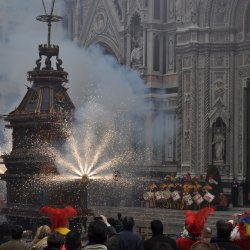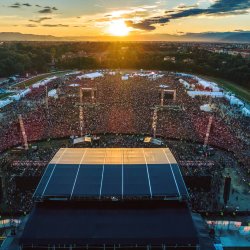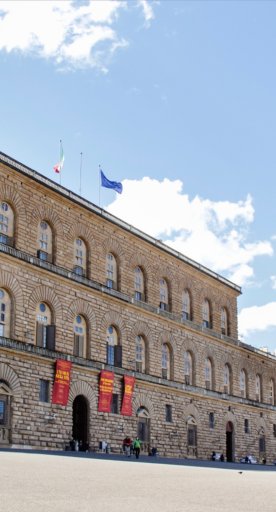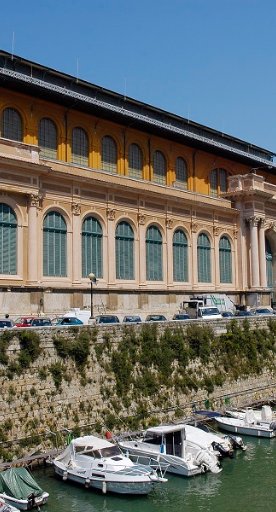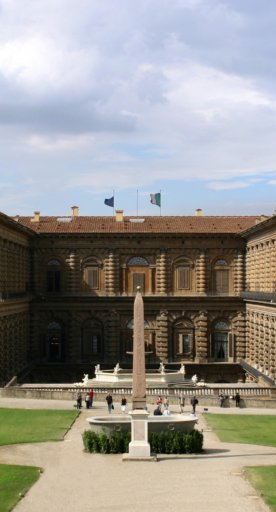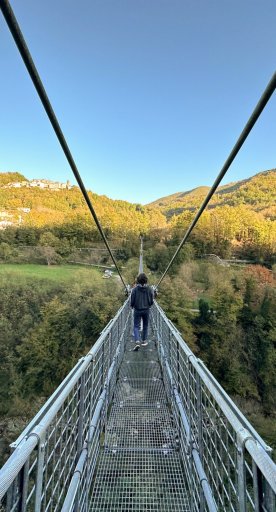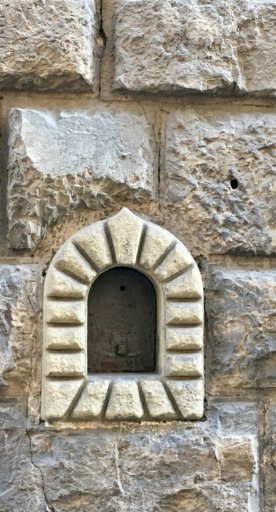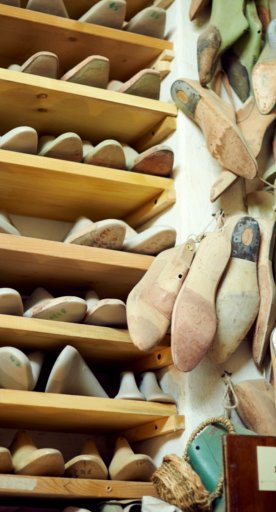
Enjoy Tuscany and its panoramic views
Catch the beauty of Tuscany from an overhead perspective or a chosen position for picture perfect scenes
Tuscany features an everchanging landscape and has got many panoramic spots overlooking the sea, the mountains, the countryside and, of course, the beautiful cities. I made a list of 8 wonderful places and scenic views not to be missed. Make up your mind, but you must be warned: choice is hard!
-
1.A suspension bridge in Pistoia Mountains
-
2.Winding roads in the countryside
-
3.A small village in the Apuan Alps
-
4.A terraced square overlooking the sea
-
5.Green hills framed in a huge work of art
-
6.A massive fortress between the sea and the mountains
-
7.An Etruscan town carved in stone
-
8.A city of art seen from on high
A suspension bridge in Pistoia Mountains

If you go to San Marcello Pistoiese, you cannot miss the amazing suspension bridge: 227 meters long and overlooking a void 40 meters deep, it connects the two sides of the river Lima. Crossing it is an unforgettable experience!
Access is free and it can be reached by proceeding towards Abetone, taking the deviation to the left after San Marcello Pistoiese. It has a large car park, there is also a bar for refreshments and a small lake.
Opened in June 1923, the bridge was built following the request of Vincenzo Douglas Scotti, owner of a Metallurgical Company. It was planned to allow the passage of workers from Popiglio to the factories on the opposite side. In 1990 it entered the Guinness Book of World Records as the longest suspension bridge ever built, a record subsequently beaten by a similar structure in Japan (the Akashi Kaikyō bridge).
Winding roads in the countryside

Deep in an unspoilt, dreamy countryside, studded with soft heaving hills, there’s a winding road lined with cypress trees. This is probably the image that best represents Tuscany and its landscapes. If you follow the ancient Via Cassia, going south from Siena, you’ll find one of the most charming and characteristic views of the region: the Val d’Orcia, a UNESCO world heritage site.
As soon as you enter this enchanting valley, a unique and evocative territory opens up before you: vines, olive trees, fields and woods forming a lovely patchwork, with villages filled with outstanding art and architecture, like San Quirico d’Orcia and Pienza.
One of the most famous scenic spots in Val d'Orcia is certainly the S-road lined with cypress trees in Lucciola Bella Nature Reserve. You can see this scenic little road from the district called "La Foce" in Chianciano Terme, south of the town of Pienza.
Also the winding road in the surroundings of Monticchiello (Pienza) is perfect for a photograph. The spot is in via Campo Alla Piana, before reaching a farm on the road.
Last but not least, the winding road in Asciano, leading to the Baccoleno Farmhouse, surrounded by the amazing Crete Senesi landscape. The dirt road lined by cypress trees is private but on the main road (the SP60 between Asciano and San Giovanni d’Asso) is the spot where you can park your car and then walk a few steps to reach the perfect point of view for a very special memory (and a very special picture).
A small village in the Apuan Alps

At the heart of the Apuan Alps, just after the crossroads for Arni on the road leading down to the coasts of Versilia, stands a peaceful oasis of beauty, a place so unexpected that it seems to come straight out of a fantasy movie. It is called Isola Santa and belongs to the municipality of Careggine, in Lucca surroundings.
Isola Santa is a very old village, built in the Middle Ages around a hospital for travellers and pilgrims on the banks of the river Turrite Secca. In particular, it was a place for travellers to recover after passing through the Foce di Mosceta, a connecting road between Versilia and Garfagnana. In 1950, the construction of a dam for hydroelectric power forced the inhabitants to leave their homes. But, later, the old inhabitants decided to give the village back its ancient beauty and charm: in the 2000s, a restoration project brought new life on the shores of its lake, but Isola Santa remains today almost a ghost town where the houses are empty and where just a few fishermen and sporadic travellers pass by.
If you want to see Isola Santa from a panoramic position, you can go to the Belvedere, near the dam.
A terraced square overlooking the sea

Piazza Giovanni Bovio in Piombino (Livorno) is at the top of its promontory, and it has a beautiful terrace hanging over the sea on three sides. Created in the 1920s by demolishing an Etruscan fortress, the peninsular terrace follows the shape of the cliff and from it you can admire a wide, amazing view of the channel of Piombino, looking over a large part of the Tuscan Archipelago, and, when the days are clear, even Corsica and Giannutri.
At the end of the terrace there’s the Rocchetta lighthouse-shaped tower in neo-medieval style.
Green hills framed in a huge work of art

Volterra is on the east side of the province of Pisa, adjacent to the province of Siena, and situated on a hill 1770 feet above sea level, between the valleys of Cecina and Dell’Era. Its origins date back to the ancient Etruscans, who used to call the city Velathri or Felathri, while the Romans called it Volaterrae.
The Etruscan walls are still visible, well preserved and enclose the city centre. Throughout the Middle Ages, the city was the bishop’s domicile, while later it was under the domain of Florence (and the Medici family), and then under the Grand Duchy of Tuscany.
Walking through the narrow streets of the centre, you might feel like time has stopped in a magical past. Before entering the town, from southest, you will see the sculpture "Tondopieno" by Staccioli, a work of contemporary art that frames the beautiful landscape in a red circle.
A massive fortress between the sea and the mountains

Fosdinovo in Lunigiana is between the mountains and the sea, a historic town which dominates the Val di Magra and Luni plains. Its position brought fortune and misfortune to its history: on the one hand the opportunity of trading and on the other hand the wars and the struggles.
The beautiful Malaspina Castle is the town's main building, a beautiful and very well-conserved fortress from which you can see an amazing view. The construction merges with the underlying sandstone rock so that the whole structure seems carved out of the earth. If you want to visit it, don't miss the "Dante chamber" where, according to tradition, the great poet Dante Alighieri slept when he was a guest at the castle during his period of exile.
An Etruscan town carved in stone

Sorano is an ancient city perched on a cliff and dug into the rock, with its charming pathways through the quarries called Vie Cave, frequented since the Etruscan period. Its historic centre is made of small streets paved with stones, going up and down, and the houses leaning up against the rock.
For a special view from the core of it, step on the Masso Leopoldino or Rocca Vecchia, a fortified structure that features an impressive terrace and a clock tower. But if you want to see the town from the outside, you can visit the Archaeological Park and take a picture from the San Rocco quarries.
A city of art seen from on high

You can admire the cityscape from different points of view. There’s Bellosguardo, in the south-west, on a small hill that offers a beautiful view of Florence. There you can find many villas with Renaissance origin that have hosted, over the centuries, several famous people like Giuseppe Garibaldi, Ugo Foscolo and Henry James.
In addition there’s Fiesole, at just 8 kilometers northeast of Florence, located on a hill with a view over the city. It has Etruscan origins and it was one of the most important towns on the southern slopes of the Tuscan-Emilian Apennines. Faesulae – as the city was known – was conquered by the Romans and then was the stage for the battle of the Goths. In the Middle Ages it suffered a decline, coinciding with the growth of Florence’s economic and political influence. By the 14th century, rich Florentines had countryside villas in Fiesole (and the Medici Villa is a precious evidence of this).
Monte Ceceri in Fiesole, a 44 hectares park, offers a beautiful view over Florence. Leonardo da Vinci's experiment with human flight took place here. Just imagine the emotion of reaching this place!








